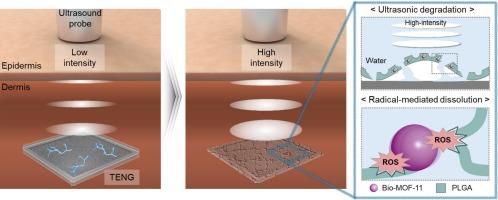作为瞬态植入物供电的摩擦电材料的声响应Bio-MOF-11
IF 22
1区 材料科学
Q1 MATERIALS SCIENCE, MULTIDISCIPLINARY
引用次数: 0
摘要
瞬态植入式医疗器械(imd)的最新进展引起了人们对生物可降解电源的关注,这种电源可以消除植入式医疗器械植入后的二次移除手术。然而,仅仅依靠材料的固有生物降解率或设备尺寸进行生物降解存在局限性。在这项研究中,我们提出了一种声介导的可降解摩擦电纳米发电机(AMD-TENG)及其操作系统作为瞬态植入式电源。我们将Bio-MOF-11引入聚乳酸-羟基乙酸(PLGA)中,作为一种耐用、高性能的摩擦电层。我们的研究结果表明,Bio-MOF-11/PLGA薄膜在低强度超声下可以产生12.5 V和87.5 μA/cm2的稳定电输出,证实了其作为imd电源的可行性。此外,表面孔隙的整合允许在高强度超声下控制生物降解,实现按需溶解和随后产生的活性氧(ROS)来加速降解。这些结果突出了Bio-MOF-11/PLGA作为摩擦层在发电和控制降解方面的效率,为瞬态imd的供电和处理提供了可持续和安全的解决方案。本文章由计算机程序翻译,如有差异,请以英文原文为准。

Sono-responsive Bio-MOF-11 as a triboelectric material for powering transient implants
Recent progress in transient implantable medical devices (IMDs) has drawn attention to the necessity for biodegradable power sources, which can eliminate the need for secondary removal surgeries after implantation. However, relying solely on the material’s intrinsic biodegradation rate or device dimensions for biodegradation presents limitations. In this study, we propose an acoustically-mediated degradable-triboelectric nanogenerator (AMD-TENG) and its operating system as a transient implantable power source. We introduce the incorporation of Bio-MOF-11 into poly(lactic-co-glycolic) acid (PLGA) as a durable, high-performance triboelectric layer. Our findings demonstrate that the Bio-MOF-11/PLGA film, when exposed to low-intensity ultrasound, generates a stable electrical output of 12.5 V and 87.5 μA/cm2, confirming its viability as a power source for IMDs. Additionally, the integration of surface pores allows for controlled biodegradation under high-intensity ultrasound, enabling on-demand dissolution and subsequent generation of reactive oxygen species (ROS) to accelerate degradation. These results highlight the efficiency of the Bio-MOF-11/PLGA as a tribo-layer in electricity generation and controlled degradation, offering a sustainable and safe solution for powering and disposing of transient IMDs.
求助全文
通过发布文献求助,成功后即可免费获取论文全文。
去求助
来源期刊

Materials Today
工程技术-材料科学:综合
CiteScore
36.30
自引率
1.20%
发文量
237
审稿时长
23 days
期刊介绍:
Materials Today is the leading journal in the Materials Today family, focusing on the latest and most impactful work in the materials science community. With a reputation for excellence in news and reviews, the journal has now expanded its coverage to include original research and aims to be at the forefront of the field.
We welcome comprehensive articles, short communications, and review articles from established leaders in the rapidly evolving fields of materials science and related disciplines. We strive to provide authors with rigorous peer review, fast publication, and maximum exposure for their work. While we only accept the most significant manuscripts, our speedy evaluation process ensures that there are no unnecessary publication delays.
 求助内容:
求助内容: 应助结果提醒方式:
应助结果提醒方式:


